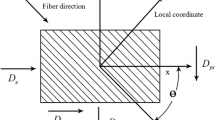Abstract
Fiber-reinforced polymers (FRPs) are sensitive to moisture diffusion. Deterioration caused by moisture can limit their service lives considerably. In this work, a three-dimensional finite element modeling and analysis framework is presented to investigate the moisture diffusion kinetics inside fiber-reinforced inside polymer matrix composites by considering different angle and cross-ply orientations. A small localized representative volume element considering a few fibers in the neighborhood of three-layer stacks has been analyzed. The emphasis is on the effect of different fiber orientations over moisture saturation time and diffusion-induced stresses. Stresses induced due to moisture diffusion in FRPs are evaluated on the free fiber ends. The numerical results from finite element approximations are compared with theories of composite micromechanics such as rule of mixtures, Halpin–Tsai model and concentric cylinder assemblage framework. It is observed that the orientation of fiber layers can greatly influence the moisture ingress inside the matrix and resulting stresses. At intermediate time durations of moisture progression, the cross-ply orientation had ~ 25% lower weight gain in comparison with the unidirectional ply orientations. The overall von Mises stresses at the fiber matrix interface were also lower in cross-ply orientations by ~ 40% in comparison with the other orientations with similar fiber volume fraction. The three-layered cross-ply, 90/90/90 orientation took almost 50% more time to fully saturate with moisture in comparison with the unidirectional, 0/0/0 orientation. The interpretations from the smaller local microstructural models presented in this work can be extended to study and design the structure scale composite layups for the improved moisture durability.















Similar content being viewed by others
References
Ostrowski K, Dudek M, Sadowski L (2020) Compressive behaviour of concrete-filled carbon fiber-reinforced polymer steel composite tube columns made of high performance concrete. Compos Struct 234:111668.
Grootel AV, Chang J, Wardle B, Olivetti E (2020) Manufacturing variability drives significant environmental and economic impact: the case of carbon fiber reinforced polymer composites in the aerospace industry. J Clean Prod 261:121087. https://doi.org/10.1016/j.jclepro.2020.121087
Adesina OT, Jamiru T, Sadiku ER, Ogunbiyi OF, Beneke LW (2019) Mechanical evaluation of hybrid natural fibre-reinforced polymeric composites for automotive bumper beam: a review. Int J Adv Manuf Technol 103:1781–1797. https://doi.org/10.1007/s00170-019-03638-w
Fuqua MA, Huo S, Ulven CA (2012) Natural fibre reinforced composites. Polym Rev 52(3):259–320
Ho M, Wang H, Lee J, Ho C, Lau K, Leng J, Hui D (2012) Critical factors on manufacturing processes of natural fibre composites. Compos Part B Eng 43(8):3549–3562
Saharudin MS, Atif R, Shyha I, Inam F (2016) The degradation of mechanical properties in polymer nano-composites exposed to liquid media—a review. RSC Adv 6(2):1076–1089
Vilaplana F, Stromberg E, Karlsson S (2010) Environmental and resource aspects of sustainable biocomposites. Polym Degrad Stab 95:2147–2161
Bakis C, Bank LC, Brown V, Cosenza E, Davalos J, Lesko J (2002) Fibre-reinforced polymer composites for construction—state-of-the-art review. J Compos Constr 6(2):73–87
Mosallam AS, Bayraktar A, Elmikawi M, Pul S, Adanur S (2015) Polymer composites in construction: an overview. J Mater Sci Eng 2(1):25
Acha BA, Reboredo MM, Marcovich NE (2007) Creep and dynamic mechanical behavior of PP–jute composites: effect of the interfacial adhesion. Compos Part A Appl Sci Manuf 38:1507–1516
Hong B, Xian G, Wang Z (2017) Durability study of pultruded carbon fibre reinforced polymer plates subjected to water immersion. Adv Struct Eng. https://doi.org/10.1177/1369433217732664
Jain D, Mukherjee A, Kwatra N (2014) Local micromechanics of moisture diffusion in fibre reinforced polymer composites. Int J Heat Mass Transf 76:199
Jain D, Mukherjee A, Kwatra N (2015) Effect of fibre topology on hygro-mechanical response of polymer matrix composites. Int J Heat Mass Transf 86:787
Korkees F, Alston S, Arnold C (2017) Directional diffusion of moisture into unidirectional carbon fibre/epoxy composites: experiments and modeling. Polym Compos. https://doi.org/10.1002/pc.24626
Jain D, Mukherjee A, Kwatra N (2016) Numerical modelling of moisture diffusion in FRP with clustered microstructures. Appl Math Model 40(3):1873–1886
Jain D, Mukherjee A (2016) Three-dimensional hygromechanical analysis of fibre polymer composites: effect of boundary conditions. Composit Part B Eng 90:203–211
Radha JC, Ranganathaiah C (2008) Effect of the fibre orientation on the sorption kinetics of seawater in an epoxy/glass composite: a free-volume microprobe study. J Appl Polym Sci 109(2):1302–1309
Vaddadi P, Nakamura T, Singh RP (2003) Inverse analysis for transient moisture diffusion through fibre-reinforced composites. Acta Mater 51:177
Bonora N, Ruggiero A (2006) Micromechanical modeling of composites with mechanical interface—part 1: unit cell model development and manufacturing process effects. Compos Sci Technol 66(2):314
Vaughan TJ, McCarthy CT (2011) Micromechanical modelling of the transverse damage behaviour in fibre reinforced composites. Compos Sci Technol 71:388
Pan Y, Xian G, Li H (2017) Numerical modeling of moisture diffusion in an unidirectional fibre-reinforced polymer composite. Polym Compos. https://doi.org/10.1002/pc.24664
Arnold JC, Alston SM, Korkees F (2013) An assessment of methods to determine the directional moisture diffusion coefficients of composite materials. Compos Part A 55:120–128
ABAQUS/STANDARD 6.13 (2019) http://www.simulia.com. Accessed 10 July 2019
Askeland D, Fulay P, Wright W (2010) The science and engineering of materials, 6th edn. Cengage Learning, Boston. ISBN 9780495296027
Halpin JC (1984) Primer on composite materials: analysis. Technomic, Lancaster
Hashin Z, Rosen BW (1964) The elastic moduli of fibre-reinforced materials. J Appl Mech 31:223–232
(2019) ABAQUS/STANDARD analysis user’s manual, vol II. Dassault Systemes, Vélizy-Villacoublay
Author information
Authors and Affiliations
Corresponding author
Additional information
Technical Editor: Paulo de Tarso Rocha de Mendonça, Ph.D.
Publisher's Note
Springer Nature remains neutral with regard to jurisdictional claims in published maps and institutional affiliations.
Rights and permissions
About this article
Cite this article
Jain, D., Vats, S., Bera, T.K. et al. A framework for three-dimensional finite element analysis of unidirectional and cross-ply composite layups through localized microstructures under hygromechanical conditions. J Braz. Soc. Mech. Sci. Eng. 42, 346 (2020). https://doi.org/10.1007/s40430-020-02424-0
Received:
Accepted:
Published:
DOI: https://doi.org/10.1007/s40430-020-02424-0




